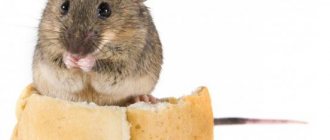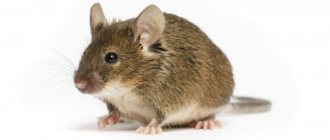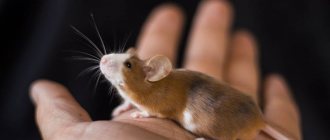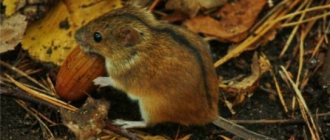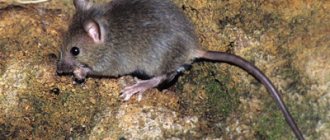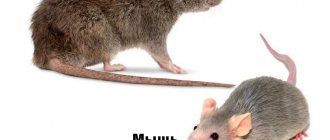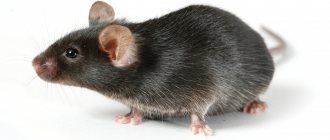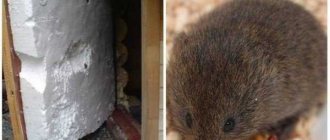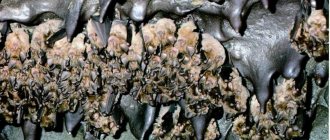The mouse family is the largest order of mammals. There are more than 300 species, 1500 varieties in the world. Among them there are herbivores and omnivores. Some breeds of mice were bred artificially as pets. Mice are widespread across all continents except Antarctica. There are no rodents high in the mountains. There are about 13 of them in Russia. Representatives of different types of mice differ in size and color.
Description of the rodent
— Advertising —
The body length of the house mouse is 6.5-9.5 cm. The length of the tail is about 60% in relation to the length of the body, its surface is covered with horny scales, which are arranged in rings, as well as short sparse hairs. The weight of adult individuals is from 12 to 30 g. The ears are round and small. The fur is dark or brownish-gray, the belly is ash-gray or white. Desert mice are lighter in color, their fur is yellowish-sandy, and their bellies are white. Domesticated mice come in white, black, yellow, blue-gray and variegated colors. Females have 5 pairs of nipples.
Maintenance and care
Keeping a decorative mouse is much easier in terms of allocating space than, say, a dog.
They spend all their time in cages, and the space they occupy is limited only by the generosity of the owner. Although an acceptable area is considered to be at least twenty, and preferably twenty-five square centimeters, you can choose a pet cage of truly enormous size, it is only important to take into account the key details
The floor of the cage should be covered with shavings or sawdust. It is better to place the feeder and drinking bowl in places where they can be conveniently taken out for cleaning, which should preferably be done every day. You also need to remove any debris every day and, if necessary, renew the floor covering. An important point will be to provide the pet with a house and other infrastructure, for example, a running wheel or all kinds of stairs and pipes. Cage occupants will likely enjoy any additions to an empty cage, but owners should keep their pets' safety in mind. Unreliable structures, as well as structures with sharp parts, can threaten their health. It is better to place the cage away from windows to avoid drafts.
Nutritional features of the house mouse
Under natural conditions, house mice feed mainly on the seeds of wild and cultivated plants. They prefer seeds of cereals, legumes and asteraceae. In addition, they feed on insects, their larvae, and carrion. Green parts of plants make up up to 1/3 of the total feed volume. When there is enough food, reserves are made.
— Advertising —
House mice consume about 3 ml of water per day and are very sensitive to dehydration.
Living next to humans, mice eat all available food, sometimes even soap, candles, and glue. Your diet includes grain, rice, oats, meat, chocolate, and dairy products.
Habitats and species
House mice are wild and not entirely harmless animals. They got their name only because they feel great and live calmly next to people. The house mouse became a representative of mammals that quickly settled over vast territories.
This small animal does not like cold and lack of moisture. Fans of the wild and harsh nature of the far north, permafrost areas, Antarctica, and highlands will not be able to take photos of house mice in their natural habitat. They simply don't survive there. But they happily live in flat areas.
The scientific world has classified the house mouse. Scientists have described about one hundred and thirty subspecies of this population. In Latin the animal is called Mus musculus. The third word in its name indicates the main habitat. Conventionally, mice are grouped into 4 subspecies:
- m. castaneus - live in Southeast Asia;
- m. bactrianus – habitat Asia, except the south and east;
- m. domestic - found refuge in America, Australia, Europe and a large area of Africa;
- m. musculus - these mice live in Eastern Europe and the vast territory of Russia.
The Japanese subspecies Mm molossinus was considered an open fifth subspecies that belongs to the main group, but according to recent data it is a mixture of Mm castaneus and Mm musculus.
Interesting!
It is a known fact that in ancient Rome no one separated mice from rats, so a rat was considered just a big mouse.
Distribution of the house mouse
The homeland of the house mouse is northern India or northern Africa or Western Asia; in all these regions the species is known in fossil form. Later, together with people, the house mouse spread throughout the world and today it is a cosmopolitan animal.
House mice do not live only in the Far North, Antarctica and in the mountains at high altitudes. Their prevalence is somewhat limited by low air temperature and high humidity. In Russia, house mice do not live in the northeast of Siberia, on the Taimyr Peninsula, near the Yenisei and Lena, in the mountain tundra.
The number of house mice varies with the seasons; at the end of winter it is smallest, and with the beginning of spring and the breeding season, the number of individuals grows and reaches its maximum in autumn.
Character
The house mouse is a rather intelligent animal, and it is also distinguished by its cunning. However, these animals are quite shy, so you should not make sudden movements or noise near their house. The house mouse (photo on the page) is also distinguished by the fact that it cannot tolerate loneliness. The animals are social, so they often need the attention of their owner or communication with their relatives. If the rodent does not receive the necessary attention, it begins to feel sad and may go wild, after which it will not be handled.
You should be careful if the following live together as mice in your house:
- rats;
- cats;
- dogs;
- birds.
These animals can pose a danger to your pet, so lack of proper attention often ends in failure.
Rodents can be kept in families with small children. House mice are quite friendly, but can bite. As a rule, untamed individuals that are not accustomed to their home environment and their owners can bite. It is best not to leave them alone with small children, as the mouse can simply run away.
Among rodents, house mice are among the smartest; they quickly learn to recognize by smell the person who brings them food, and often greet him with a joyful squeak.
They are easily tamed and can even be trained. The animal can be taught the command “Home!”, “Serve!” and “Come to me!” The animal can also remember its name and respond to it.
Common types of house mouse
Approximately 130 subspecies of the house mouse have been described, which are grouped into main subspecies according to their habitat regions:
- Mus musculus musculus is a resident of Eastern Europe, from Poland and further east, most of Russia.
- Mus musculus domesticus - habitat includes Europe, America, Australia, Africa.
- Mus musculus bactrianus - found in Asia, except the southeastern region.
- Mus musculus castaneus - distributed in southeast Asia.
Interestingly, in the times of Ancient Rome, mice were not distinguished from rats; the former were called Mus Minimus, and the latter – Mus Maximus.
So what to do?
I will buy some kind of metal or plastic profile and attach it around the perimeter to the foundation inside the subfloor. Such a barrier will prevent mice from climbing the walls. If the mice remain next fall, I will do the same on the outside. Here is something similar I plan to do (side view).
Dmitry Belkin, who asks questions but often has no answers.
Article created 01/20/2014
House mouse behavior
The house mouse is an inhabitant of a wide variety of landscapes. The species is very closely related to people, that is, it belongs to synanthropic species, and often lives in residential buildings and outbuildings.
In the northern regions, seasonal migrations are typical for mice. So, at the end of summer and autumn, they move en masse closer to feeding areas: residential buildings, vegetable and grain storage facilities, and warehouses. The range of such migrations reaches 3-5 km. House mice usually overwinter in forest belts, stacks and stacks. In spring, rodents return to their natural habitats, fields, vegetable gardens and orchards.
In the deserts and semi-deserts of the southern part of their range, house mice live all year round outside human habitation, being close to oases and reservoirs.
Under natural conditions, house mice live on soft, moist soils, where they dig small burrows: up to 1 m in length, 20-30 cm in depth and 1-3 entrances. In winter, the burrow deepens to 50-60 cm. The diameter of the nesting chamber is 10-25 cm; mice line it with soft plant rags. They may also occupy the burrows of other rodents (voles, mole voles, gerbils). Next to humans, house mice live under the floor, in attics, and in heaps of garbage. The nest is built from any available materials: paper, scraps of fabric, wool, feathers, artificial fibers, and kept clean. In nature, they lead a twilight and nocturnal lifestyle; when around people, they adapt to their activities. When moving, they adhere to constant routes and create noticeable paths with heaps of droppings and dust.
House mice are agile, nimble animals, they run fast (reach speeds of up to 12-13 km/h), climb, jump and even swim, but they do not go far from the nest. Under natural conditions, each house mouse occupies an individual area of up to 1200 m² for a male and up to 900 m² for a female, or they live in groups of one dominant male and females with offspring.
Mice: what they are, lifestyle in the wild and near humans.
Mice are the oldest companions of humans. Heroes of fairy tales and legends... When it comes to mice, everyone immediately remembers the “little furry animals” that live in houses, shops, and warehouses. When they settle in a house, they gnaw holes in the walls through which heat escapes, eat and spoil vegetables and cereals, and spread many infections. Having entered the apartment, mice not only master its area, but to a large extent also its volume. They climb onto cabinets and get inside them, climb onto shelves, tables, mezzanines, beds, even into the stove and refrigerator! Mice nests were found under the roots of indoor plants, in the stove, inside a pillow, among linen, inside upholstered furniture…..brrr. No matter how many centuries humanity has lived, the endless war against gray pests continues. However, even in the conditions of constant struggle with humans, the mouse tribe does not give up, but grows and prospers safely. Let's talk about this animal in more detail to know its habits and ways to deal with it. Mice are a family of mammals from the order of rodents. There are about 40 species that are distributed everywhere on Earth, except Antarctica and the Far North. Some of the species can only live at home with humans (scientifically: synanthropic organisms). The Mouse family is a group of rodents that are very diverse in size, appearance and lifestyle. The sizes of mice range from small to large: body length 5-48 cm. Almost all rodents of this family have a tail length exceeding half the body length. Mice are nocturnal creatures and are active at night. In the wild they feed on seeds, some on animal food. Reproduction occurs during the warm period; in human dwellings - year-round. Achievement of full maturity occurs at the age of 1.5 to 3 months. Mice are natural carriers of a huge number of parasites and keepers of the causative agents of many human diseases, including dangerous infections. These rodents harm grain and forestry, spoil materials and food. And, despite the fact that mice have a lot of enemies and are constantly in mortal danger, they survive. This is due to the amazing ability of mice to adapt to their environment. They can survive even in a refrigerator with temperatures down to -10 degrees. In the absence of other food, mice are able to feed themselves on crumbs, seeds and roots. Due to the nature of their bodies, mice consume very little water. Their teeth are adapted to feeding on solid plant foods. On the upper and lower jaws of rodents there is a pair of incisors, the front walls of which are covered with a thick layer of enamel, and the lateral and posterior walls are covered with a thinner layer (or are completely devoid of enamel coating), as a result of which the incisors of these animals are ground unevenly and always remain chisel-shaped and sharply sharpened. Rodents' incisors grow throughout their lives. For this reason, rodents must constantly grind down these teeth, otherwise they can “grow” through the opposing jaws, and the animal will inevitably die. The territory of central Russia is inhabited mainly by four species of mice: the field mouse, the forest mouse, the little mouse and the house mouse. Harvest mouse
This species is very easy to distinguish from all others by color: a narrow black stripe stretches down the middle of the reddish-buff back. The size of field mice in the Urals is 10–11 cm, tail – 9–10 cm, weight 30–40 g. In the lowland regions of the Southern, Middle and partly Northern Urals, this is a common and numerous species. They live in large communities with a strict hierarchy. This animal lives not only in fields, but also in various types of forests, clearings, burnt areas, in the valleys of steppe rivers, and prefers fairly moist places. The animals feed on grain, seeds, insects, berries and, to a lesser extent, green plants. Reproduction lasts throughout the warm period of the year - from the end of March to the end of September, during which time females give birth to 2-3 litters with 6-7 cubs. Mice dig shallow burrows that may have three or four exits and one or two chambers located at shallow depths; sometimes they make spherical grass nests. The field mouse is nocturnal. The ability to jump running is poorly developed. It reaches high numbers in gardens (including in fairly large cities), various plant nurseries, in outbuildings and residential buildings, and in the fall it concentrates in heaps and stacks. In autumn and winter, the field mouse can be found in populated areas, in stacks, in haystacks, in straw sweeps, on threshing floors, in barns, etc. In winter it does not hibernate. The field mouse can rightfully be considered a major agricultural pest, mainly of grain crops. Damages potatoes, carrots, tomatoes, pumpkins, sunflowers, as well as sometimes standing grains and in stacks; especially harmful to grain crops. The field mouse feeds on seeds, leaves, berries, stems and roots of herbaceous plants and insects; the storage instinct is less pronounced than in wood mice. The field mouse is a rodent that causes great harm to agriculture, farmers, gardeners and gardeners. Read more about the lifestyle, habits and habitats of the field mouse in the following article.
Wood mouse
Body length up to 12 cm. The tail is approximately equal to the length of the body. A monochromatic light red or gray coloration of the back, a white belly, a long tail - these are the distinctive features of this animal. Some individuals may have a small yellow spot on the chest. A very dexterous and nimble animal, it moves in leaps and bounds. The length of the jump is from 10 to 30 cm, and some subspecies (yellow-necked mouse) the length of the jump reaches 1 m. Many of them climb trees well and can climb to great heights. The main food of the wood mouse is seeds, especially of tree species; in second place are berries and animal food (mainly insects), as well as green parts of plants. The wood mouse prefers open areas of broad-leaved and mixed forests, clearings, shrubs, and crops. In the conditions of the Urals, where crops are constantly in contact with either forests or stakes, the wood mouse constantly lives in the fields. The wood mouse adapts well to a wide variety of conditions and even inhabits the steppe, thickets of weeds, bushes, heaps of stones, and buildings. It makes reserves for the winter, which it hides in underground burrows, birdhouses, in the dust of rotten trunks of fallen trees or in the cracks of living trees. For a nest, the wood mouse digs holes under the roots of trees and under stones. The nesting chambers are lined with dry blades of grass and moss. They can make nests in tree hollows and in birdhouses - at a height of up to 10 m. You can also stumble upon residential nests with young under a board or piece of plywood lying in the forest. A young female gives birth to cubs at the age of 80-90 days, the number of litters is from 2 to 4, each with an average of 6 cubs. The young reach sexual maturity at 2.5-3 months. One wood mouse eats an average of 17–25 g of seeds per day. Causes serious damage by eating seeds and seedlings of trees. It is especially harmful in fruit nurseries and forest plantations. It has been established that during years of mass reproduction, mice can completely destroy the entire seed crop of oak, beech, linden and maple. Particularly noticeable is the harm caused in fruit nurseries and when planting shelterbelts by eating the sown seeds and damaging the seedlings. The wood mouse does not hibernate, so during the cold season it enters living quarters and spoils bags of flour, grain, and fruit. The wood mouse is a dangerous pest of forest and garden trees, crops, and harvested crops. Read more about the lifestyle, habits and habitats of the wood mouse in the following article.
Little mouse
This is a tiny and cute animal. The body length of a baby mouse does not exceed 6–7 cm, and its weight is 7–10 g. It is the smallest rodent in the Urals. The color of the fur of baby mice can be different - bright red, brownish, reddish; the animal’s belly is white. Unlike other mice, the baby's muzzle is shortened, slightly reminiscent of the muzzle of voles, and the eyes and ears are small. But no other mouse has such a tail - it is long (equal to the length of the body) and can wrap around twigs and grass stems, which allows the animal to easily climb bushes and individual plants. In the Urals, the little mouse lives in the southern regions of the forest zone. It is extremely difficult to see and observe her. And the point is not only in its small size, but also in the amazing ability of this animal to hide and hide its presence. She runs extraordinarily fast and climbs with the greatest perfection and agility. Hanging on the thinnest branches of bushes and on the stems of grass, which are so thin that together with her they bend towards the ground, she runs upward along them, and almost as quickly runs through the trees, and with particular dexterity she clings with her tail. She is also equally good at swimming and diving. The baby mouse is active all day, every three hours a short sleep and feeding alternate each other. The baby mouse feeds on all available seeds and fruits, and in the fall it sometimes makes small reserves of grain, which will come in handy in the coldest weather. After all, animals do not hibernate during the winter. In search of food, they scour under the snow, but not far from their “winter apartment.” This is simply a constructed hole or a ground shelter - among dead wood, under stacks and haystacks. If the winter is very harsh, the animals move into human buildings. In the cold season, males and females live separately, uniting in pairs only to breed offspring, but in the most favorable places for wintering, for example, in stacks or granaries, they form clusters of up to 5 thousand individuals. According to biologists, 95% of all animals in the population die in winter. The main causes of mortality are cold or wet weather, sudden frosts and predators such as weasels, stoats, foxes, cats, owls and crows. In nature, populations of this rodent are characterized by an extremely high reproduction rate, but at the same time very low survival rate. The baby is very gluttonous, eating about 5 g of food per day, which is only slightly less than its weight. The baby mouse is a natural carrier of pathogens of tick-borne encephalitis, tularemia, etc.
House mouse
Body length from 6.0 to 10 cm. Weight - 12-30 g. The skin is dark or brownish-gray; belly - from ash-gray to white. The house mouse settles near human habitation. Habitat: everywhere except in the Far North. Factors limiting its spread include low air temperatures and high humidity. In general, the house mouse is closely related to people and inhabits residential buildings and outbuildings. But house mice can also be found in nature, where they migrate during the warm season. Such evictions in the Urals are known not only in the southern regions, but even in the tundra zone. With the onset of cold weather, house mice move back into feeding areas: residential buildings, vegetable and grain storage facilities, and warehouses. The range of autumn migrations can reach 3-5 km. With the arrival of spring, mice leave their “winter quarters” and return to natural habitats, fields, vegetable gardens, and orchards. The house mouse is a heat-loving rodent, and since it does not store any winter food reserves or warm shelters, it is forced to find all this in a person’s home. House mice are smaller in size than ordinary wood mice and differ from them in the structure of their upper incisors. House mice feed on a wide variety of foods, everything they can find in a human home, and when living in natural conditions they prefer the seeds of various plants. They can breed in buildings all year round, with each litter containing 5–7 young. Mice begin to live independently at the age of about one month. In nature, house mice are crepuscular and nocturnal animals, but in human housing they adjust their daily routine to the activities of people. Under artificial lighting, mice sometimes remain active around the clock, reducing it only during the period of human activity. House mice are very active, nimble animals; They run fast, climb, jump and swim well. In conditions of high population density, mice settle in small colonies or family groups, consisting of one dominant male and several females with offspring. Hierarchical relationships are established among the members of the colony. Adult males are quite aggressive towards each other, females show aggression much less often. Clashes within family groups are rare; they usually boil down to the expulsion of grown-up offspring. In nature, the house mouse is a typical seed eater; It feeds on the seeds of various wild and cultivated plants. Prefers seeds of cereals and legumes. The diet also includes insects and their larvae, carrion. Green parts of plants, depending on the availability of drinking water, can account for up to 1/3 of the volume of food consumed. A mouse needs up to 3 ml of water per day. When fed exclusively dry food and low relative air humidity (30%), mice died from dehydration after 15-16 days during the experiment. Next to humans, mice are content with almost any available food, including soap, candles, glue, etc. They equally readily feed on grain, meat, chocolate, and dairy products. The house mouse is very prolific. Under favorable conditions (in heated rooms, in stacks) it reproduces all year round. During the year they bear 5-10 litters (up to 14), with 3-12 cubs in each. Pregnancy lasts 19-21 days. Mice are born blind and naked. By the 10th day of life they are completely covered with fur, by the 14th day their eyes open, and by the 21st day they become independent and disperse. Sexual maturity is reached at 5-7 weeks of life. House mice have well-developed sensory organs. Only their eyesight is rather weak. At the same time, house mice have very acute hearing. The range of frequencies they perceive is very wide: mice can hear sounds well with a frequency of up to 100 kHz (in humans, the upper threshold of hearing sensitivity is 20 kHz). In low light conditions they are easily oriented with the help of vibrissae (tactile long, stiff hairs protruding above the surface of the coat or simply in whiskers). The role of smell in the life of mice is extremely high: from searching for food and spatial orientation to recognizing relatives. Each mouse has apocrine sweat glands on its paws, with their secretions they automatically mark territory when moving. When severely frightened, a substance is released into the urine of mice, the smell of which causes fear and flight of other animals. This “alarm signal” is quite persistent and remains on objects for a quarter of a day, informing all mice about the danger of this place. Mouse urine is very concentrated; because of it, a specific “mouse” smell appears in rooms where mice are found. Character: House mice are curious, lively, intelligent and very timid animals. Unexpected noise or sharp sounds frighten them. Mouse hearing is very sensitive to sounds and can distinguish frequencies up to 100 kHz. This figure is 5 times higher than that of humans. The sense of smell of mice perfectly helps them navigate in space and choose the direction of movement. Vision in animals is poorly developed and is focused on searching for distant objects. Nearby, mice are practically blind, but they are well oriented in space thanks to smells and sounds. They are social animals and do not like loneliness. These animals move very quickly - their speed can reach 12-13 km/h, so it is quite difficult to catch a mouse on your own. They almost always follow a predetermined route along which they leave excrement. You can see these “mouse tracks” a few days after the rodent appears in your home or warehouse. The house mouse causes some damage to crops, but the main damage is caused by eating and contaminating food and animal feed with feces and urine, as well as damaging furniture, electrical wiring, clothing, and books, on which mice sharpen their teeth. It is believed that the fight against these rodents was the main reason for the domestication of the cat. House mice are carriers of many infections that are dangerous to humans: pseudotuberculosis, tularemia, plague, etc. Mice easily get caught in various mousetraps. Mousetraps are a fairly effective way to control their population, as long as it is not too large. When a room is massively infested with mice, the effectiveness of such control is significantly reduced. Ultrasonic rodent repellers or poisoned baits come to the fore.
House Mouse Reproduction
Under favorable conditions, house mice breed throughout the year. Over the course of a year, females bear 5-10 litters, each containing 3-12 babies. Males, in order to attract females, emit ultrasounds in the range of 30-110 kHz, which are similar in complexity to bird songs. Pregnancy lasts 19-21 days. Mice are born blind and naked. On the 10th day of life, they are completely covered with fur, their eyes open 2 weeks after birth, and in the third week the babies begin to live independently. They become sexually mature at 5-7 weeks of life.
Life expectancy in natural conditions is 12-18 months, in captivity – up to 2-3 years.
Mouse trap crushers
There are masher mousetraps, which are dies with a spring. The advantages of such devices are:
- significant efficiency;
- durability;
- cheapness.
They must be used carefully. There are several options for such devices
Steel mousetrap “FIT”
This mousetrap is a classic design with a wood base and a durable steel fixture. As soon as the rat wants to eat the bait, the mechanism will immediately slam shut. Such mousetraps are popular due to their low cost and trouble-free operation. The disadvantages include the fact that death does not occur instantly, but after some time. The tree gradually becomes saturated with the smell of dead rodents, and subsequently the rats will avoid old mousetraps.
Plastic mousetrap “Mr.Mouse”
This classic mousetrap is made of plastic. If we compare it with a wooden structure, it does not become dirty or saturated with odors. It can be used many times. It is safer for humans during use because the principle of operation resembles a large clothespin. The bait can be chocolate, peanuts, seeds.
Trap "House"
This trap does not kill rats, but only locks them inside. Pests cannot get out. The trap consists of a plastic pipe, which is bent at a certain angle, and two doors. After it is installed, you need to remove the back cover and put in the bait. Then place the trap in the desired place, close the back cover, and open the front door. The door is designed for a rat. When the animal crawls towards the food, it will automatically close.
Natural enemies
House mice are hunted by cats, foxes, small mustelids, mongooses, large lizards, snakes, birds of prey, crows, and shrikes. Rats also often kill and eat their smaller counterparts.
But house mice can also be predators. So, they were brought to the South Atlantic island of Gough, took root and multiplied to a number of 700,000 individuals. Later, large mice began to attack albatross chicks; in a year they destroy more than 1 million chicks.
Every mouse has its own hole
Each animal needs its own special space, which it will consider “its place” - sacred and inviolable. Therefore, before you bring mice home, you should take care of where they will live. It was before, not after. Because jars and cardboard boxes are absolutely not suitable for rodents. And any move is always stressful.
Avoid aquariums as well. They are cramped, stuffy, hot, the mouse will not be able to move normally in them and arrange a secluded corner for itself. The best solution would be a spacious cage with metal bars.
Rodent cage
Be sure to make it yourself or buy a small house - a hole where the mouse will spend all day long.
Add a wheel to provide your pet with physical activity and fulfill his need for movement. For the same purpose, take care of shelves, ladders and ropes. The animal will be happy to show you its dexterity, and you will also have fun watching its amusing movements.
Sawdust for rodents
Litter is a very important element. The layer should be quite impressive - at least 5 mm. Animals use it not only for its intended purpose, but also to decorate their house, and when there are drafts or low temperatures, they burrow into it to keep warm.
The material should be natural and preferably inexpensive: sawdust, dry peat crumbs, shavings, hay. Avoid cotton wool and sand - the first absorbs odors too well and gets tangled between your fingers, and the second can become a breeding ground for lice. But something tells us that you don’t want such neighbors.
Interesting facts about the rodent:
- House mice have poor eyesight but very acute hearing. They are capable of perceiving sound with a frequency of up to 100 kHz (the upper threshold of human hearing sensitivity is 20 kHz). In dimly lit places they navigate using vibrissae. A keen sense of smell helps mice in finding food, orienting themselves in space, and recognizing their relatives.
- The house mouse's harm to humans consists of eating grain crops, contaminating food and animal feed with feces and urine, damaging furniture, electrical wiring, clothing, and books. The fight against house mice was one of the reasons for the domestication of cats by humans. In addition, house mice carry many infections dangerous to humans, for example, pseudotuberculosis, vesicular rickettsiosis, leptospirosis, tularemia, and plague.
- At the same time, house mice also bring benefits to humans, since they are bred as domestic and laboratory animals, “food” animals for terrariums. Mice are used in preclinical research as experimental animals and model organisms due to their ability to reproduce rapidly.
- In 2013, a monument to a laboratory mouse was erected in Novosibirsk as recognition of the role of the rodent in genetics and experimental medicine (see photo).
Origin of the species and description
The vole mouse, as the mammal species field mouse (Apodemus agrarius) is often called, belongs to the genus Wood and field mice, which is part of the Mouse family, which belongs to the order Rodents. Animals are endowed with all the main characteristics of the Rodent order: They have upper and lower pairs of incisors, which constantly grow and do not have roots; Consume plant foods; They have a long cecum; Early puberty; They have high fertility and produce several litters per year.
How long do mice live at home?
The average lifespan of a domestic rodent is about two years. Wild members of the family live much shorter: from a year to a year and a half, which is associated with a large number of natural enemies - predators who are not averse to eating fresh “mouse”. And within the population, skirmishes often occur in the struggle for territory, often ending in death.
The age of a mouse is usually counted not in years or even months, but in days. According to this calculation system, it is believed that rodents live no more than 1000 days. A rare individual exceeds this figure, but on average the number of days lived is 650.
80% of human genes have a comparable gene in mice
The mouse is an excellent model for studying human diseases because its DNA organization and gene expression are similar to those of humans: 80% of human genes have a comparable gene in mice. These rodents have a reproductive and nervous system similar to humans, and they suffer from many human diseases such as cancer, diabetes and even depression. Research in mice has helped us understand both human physiology and the causes and treatments of disease.
Without mice, organ transplantation, IVF, the creation of most vaccines and drugs, and understanding the immune system would be difficult.
Mice are crepuscular animals
Mice are sensitive to bright light, so they are usually nocturnal or crepuscular. Commensal mice adapt to the daily routine of humans. Rodents alternate between sleep and wakefulness for 0.5-1.5 hours. The mouse's activity range is usually limited to an area with an average radius of 3 meters.
Using its superior senses of hearing, smell, taste and touch, the mouse becomes an expert in its range, learning and remembering the location of food, paths and obstacles. When a new object comes into their range, mice are usually not afraid to explore it.
Features of feeding
Its well-being depends on what a white mouse or any other decorative mouse eats. A rodent's diet must contain all the necessary components for its full development.
Ready-made feed
You can purchase ready-made food for decorative mice at a pet store. It is a mixture of nutritional components that has a balanced composition taking into account the characteristics of a given rodent.
Manufacturers have already taken care of the complete diet of ornamental mice and have taken into account all the recommendations on what to feed them.
The finished mixture includes:
- wheat;
- barley;
- millet;
- buckwheat;
- peas;
- corn;
- nuts;
- sunflower seed kernels.
However, you cannot feed a decorative mouse only with ready-made food. Her menu should also include natural products. Only in this case can the likelihood of developing diseases be reduced to a minimum.
Feed
Natural diet
House mice eat the same things as hamsters. Among vegetables, rodents prefer potatoes, beets, and carrots. These pets also enjoy eating apples, pears, cucumbers and zucchini.
Other things you can feed mice include:
- boiled chicken breast;
- low-fat cottage cheese;
- dried fruits;
- eggs;
- ready-made porridge.
All these products can be given to a decorative mouse no more than 2 times a week. In the summer, you need to introduce fresh greens into your diet, namely dandelion, plantain, and nettle leaves.
Prohibited Products
There are a number of products that are strictly prohibited to be given to decorative mice. Otherwise, it can cause disruption of the digestive system and negatively affect all internal organs.
Prohibited products:
- Red beetroot;
- snacks;
- salty, sweet food;
- bread;
- fatty food;
- mushrooms;
- canned food
What does a mouse eat?
The basis of the diet of mice is plant food: grass seeds, fruits of trees or shrubs and cereals (wheat, oats, barley, millet, buckwheat). Mice that live in swampy areas, wet and flooded meadows, feed on leaves, buds or flowers of plants and shrubs. Some types of mice prefer protein supplements such as insects, worms, beetles, and spiders. Once in homes, these animals happily gnaw on potatoes, sausage, baked goods, eggs or cheese.
We invite you to familiarize yourself with the Red-eared turtle: description of the species
The mouse does not hibernate in winter and can move under the snow crust without appearing on the surface.
To survive the cold, she has to create substantial food reserves in pantries located near the entrance to the burrow.
Damage caused by mice
The destruction of such mice is caused by the damage they cause to human supplies, as well as equipment and household appliances.
Wild house mice, which have been fought by humans for centuries, are capable of eating almost anything. As a result, food, candles and soap, wiring, etc. become eaten away in the house.
Animals in warehouses gnaw grain, destroy crops of various root crops, eat cereal reserves, and, in addition, significantly pollute the house with the products of their vital activity. They actively excrete their waste, so even a small population can cause enormous harm. Thus, the animals do not eat the bulk of the grain, but rather pollute it.
In addition, house mice (we will learn how to get rid of them below) are carriers of a huge number of pathogens of various diseases. They can transmit E. coli, helminth eggs, and cause plague and typhoid fever to humans. They are often inhabited by blood-sucking insects, including fleas and ticks, which happily spread to humans.
Consequently, house mice can cause significant harm. Unfortunately, not everyone knows how to get rid of them. Professional extermination of animals is becoming the main activity for suburban areas, private homes, catering organizations, as well as various types of institutions. This service can be ordered from specialized companies, or you can use a mousetrap the old fashioned way.
Mice are talented athletes
Photo: HomeServe
Mice can jump almost 50 centimeters in height from a standstill and jump from a height of 4 meters without injury. But jumping is not all they are capable of. They are also excellent climbers and swimmers. But the cool thing about them is that they can squeeze through holes the size of a coin. And they are not bad sprinters; they can accelerate to 13 km/h !
How long can a mouse live without food and water?
For domestic decorative mice, the average daily amount of food that they must receive for full functioning has been determined. These numbers differ slightly for different breeds. Water must be present in the drinking bowl at all times.
Metabolic and energy processes in rodents proceed very quickly. To replenish energy reserves, the mouse usually feeds 3-4 times per hour. According to research, a mouse can live without food for up to 10 days. It is much more dangerous for an animal to remain without water. Death from dehydration occurs very quickly. Left without food and water, a mouse will not live even three days.
External differences
The main signs of differences between rats and mice can be observed in external characteristics. First of all, they are clearly visible in the mass of animals, as well as in the structure of the body. Based on them, you can easily determine which representative of the rodent family is in front of you.
Dimensions
The most significant difference between rodents is determined by size. Rats have significantly larger dimensions and a stocky body. The length of an adult can reach 30 cm, not counting the tail. At the same time, weight indicators fluctuate between 600–700 g. A mouse is a smaller rodent. It rarely grows more than 10 cm in length, and its weight does not exceed 30 g.
Tail
It is also not difficult to distinguish animals by the characteristics of the tail. In rats, it looks more massive, thick, has an impressive length, which is sometimes not inferior to the length of the main body, and sometimes exceeds it, reaching up to 35 cm. The tail is bald or bristly, depending on the species. In small rodents, the length of the tail ranges from 4 to 6 cm, almost all over it is covered with small hairs.
Find out also what to feed and how to care for a decorative rat.
Head
The shape of the head of a rat and a mouse also has significant differences. The former has a more elongated, pointed muzzle. The organs of vision are poorly developed. Small black or red eyes are deep-set and have a small viewing angle, so the animals have to constantly turn their heads to examine their surroundings. It is interesting that they see it in gray tones, and red objects are transformed into black.
In mice, the shape of the head is more rounded, flattened, and its size is much smaller. But the eyes, compared to the size of the muzzle, are large, convex, and expressive. The animal has developed farsightedness.
Important! Both types of rodents have teeth that grow throughout their lives, so they need to be given hard objects to chew on that can grind down their incisors.
Paws
There are practically no calluses on the rat's paws, which are necessary for climbing. But there are movable fingers with sharp claws. Thanks to this property, rodents can move freely through trees. Sometimes they make homes for themselves in abandoned hollows. The excellent muscularity of the paws allows rodents to jump long distances. Another advantage of the limbs is the presence of membranes between the fingers, which are similar in appearance to folds of skin.
They make rats excellent swimmers, capable of obtaining food in a body of water. When moving along a horizontal surface, the paws of rodents are widely spread. If you manage to examine the footprint, you will notice that the angle between the outer phalanges is about 180°. Since the predator often moves by jumping, the distance between the tracks can also be impressive.
You may find it useful to know what types of domestic rodents there are.
The legs of mice are short. Each of them has 5 tenacious fingers, so these small rodents are able to move through trees. However, their limbs are not as powerful as those of rats. They move mainly in mincing steps, with the toes spread minimally, and the distance between the tracks is about 1 cm.
Wool
Mice have softer, more delicate fur. In nature, its predominant color is brownish-gray or ash-gray, but it can vary depending on the environment. For example, desert mice have a yellow-sandy coat color, and among decorative species there are white, black, gray-blue, and variegated tones.
Did you know? Mice keep their homes clean and tidy, and with droppings they mark routes to food sources.
Rats have thicker, longer, and coarser fur. The most common colors are gray and dark brown. In individuals bred as decorative domesticated animals, many other shades are found: white, gray, reddish, spotted, etc.
Ears
The rat's ears are straight, even, pointed towards the top.] Hearing is very well developed - the animal perceives sounds with a frequency of up to 40 kHz, while humans - up to 20 kHz. In mice, this figure is even higher - animals perceive sounds with a frequency of up to 100 kHz, although the hearing organs themselves are small, rounded, rolled up.
